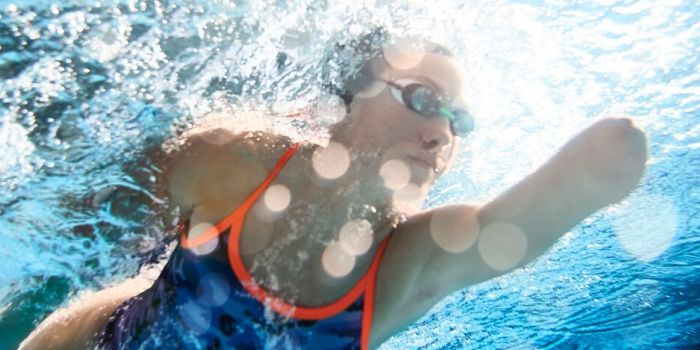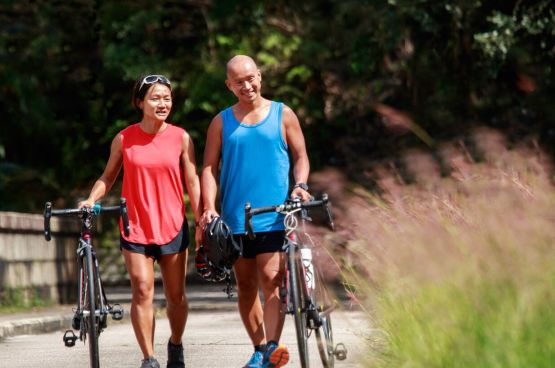Seven inclusive sport activities
Are you looking for ways to get active? Taking part in sport or physical activity can be a challenge if you have limited mobility or a disability. But, there are many ways you can build movement and physical activity into your routine.
Here, I list seven inclusive sports and activities, and explore the health benefits of being active.

How can sport and exercise benefit me?
You can benefit from exercise, no matter what your ability is, or how old you are. Research has shown that it can strengthen your muscles and bones and help you to stay a healthy weight. Finding a sport that you enjoy can also be a fun way to boost your activity levels and keep fit.
Exercise isn’t just good for you physically. The mental health and wellbeing benefits of exercise are also well known. It helps to:
- improve your sleep
- improve concentration
- reduce the risk of depression
- boost your confidence and social skills
What type of sports are inclusive for people with disabilities?
Here are seven inclusive activities that you can try.
1. Swimming
Swimming has lots of health benefits and is fully inclusive. Swimming pools need to be accessible to wheelchair users by law. They have special equipment (hoists) to help people with limited mobility to access the water. As water supports your bodyweight, it can give you a sense of freedom as you float or swim in the water. It’s also a low-impact sport. This means it doesn’t put a lot of strain on your joints and muscles.
2. Basketball
People with different disabilities play basketball. It’s a great cardio activity, and it has lots of health benefits. For example, it will help you increase muscle strength, especially if you’re a wheelchair user. If you’re looking to take part in a team sport, basketball could be a great activity for you. Some basketball clubs also offer supportive aids, like ear defenders (headphones that reduce external noise), depending on your needs.
3. Tennis
There are different types of tennis that are suitable for people with a range of physical disabilities, including wheelchair users. Tennis is also a popular sport for people who are partially sighted or blind in the UK. You play with a tennis ball that makes a noise so you can hear where it bounces when you hit the ball. As well as being a good cardio workout, tennis can also benefit your self-confidence, and reduce stress levels. Wheelchair tennis has the same rules as tennis, except the ball can bounce twice. Sensory tennis is also an option for people with complex disabilities.
4. Badminton
Badminton’s popularity as a sport is growing among people with a range of disabilities. Para badminton is now included in the Paralympic games. Playing badminton can help to reduce anxiety and improve your heart health. Badminton is also a social sport, and it can be a great way to connect with other people. For wheelchair users, it can also be a good way to strengthen your upper body muscles.
5. Rugby
Rugby is a full contact team sport for people of all genders with a disability. This means you make contact with other players during play. Wheelchair rugby is played indoors in teams of four players. You score a try (goal) if you carry the ball across the line of the goal area. The team with the most tries wins. Playing rugby can improve your upper body strength and also help to reduce stress. It could be a great option if you like fun and fast-paced team sports.
6. Goalball
Goalball can be played by people with a range of disabilities. It is particularly popular with people who are partially sighted or blind. Goalball is played in two teams, made up of three players. The aim is to score a goal by bowling the ball along the floor so that it crosses the other teams goal line. The ball has bells inside which can help everyone playing to locate the ball during the game. Goalball can improve your cardiovascular fitness and also increase upper body strength.
7. Skiing
If you like snow sports, skiing might be a great activity to try. It can help you to build muscle and is a great way to meet other people. Adapted ski equipment is available, to enable people with different disabilities to take part in snow sports.
If you are partially sighted or blind, there are headsets you can wear that will keep you and your ski guide in contact while skiing. Or, you may prefer to ski with a guide either behind or in front of you.
Wheelchair users can also use bi-skis, which allow you to be seated during skiing. Three and four-track skis are a good option if you can stand but need support to keep your balance. Lots of indoor snow centres now have adaptive snow sport sessions, so why not find your local centre and get involved!
How much exercise should I be doing?
It’s recommended that adults with a disability do at least 150 minutes of moderate intensity exercise each week. This type of activity raises your heart rate, and makes you feel warmer. What’s important is to move more, whatever activity you choose. The more you can do, the greater the benefits are likely to be.
If you don’t exercise often, start slowly to build up your fitness. Listen to your body and get active at a pace that you feel comfortable with. Warming up before and after exercising can also help to reduce your risk of injury.
Where can I find out more about inclusive sport?
The Activity Alliance, a charity acting as a voice for disabled people in sport and activity, has lots of helpful advice to help get you started. They also have an online search tool to help you find inclusive gyms in your local area.
If you want to find an activity you can do at home or in your area, visit the Parasport website. This is an online space where you can search for inclusive activities, clubs and opportunities in your local area. Getting started and then staying motivated can sometimes be hard. But there are lots of ways to build all kinds of activity into your lifestyle. The most important thing to remember is to have fun.
Do you know how healthy you truly are? Bupa health assessments give you a clear overview of your health and a view of any future health risks. You'll receive a personal lifestyle action plan with health goals to reach for a happier, healthier you.
-
Sources Sources
- Equality and Sport Research. Sport Scotland. Sportscotland.org.uk. Published January 2016. https://sportscotland.org.uk/
- Physical activity for general health benefits in disabled children and disabled young people: rapid evidence review. Department of Health & Social Care and Office for Health Improvement & National Disparities. Gov.uk. Last updated 12 April 2022. https://www.gov.uk/childcare-parenting/childrens-health
- UK Chief Medical Officers’ Physical Activity Guidelines. Department of Health & Social Care. Gov.uk. Published 7 September 2019. https://www.gov.uk/government/collections/physical-activity-guidelines
- Mind. Physical activity and your mental health. Accessed 6 September 2022. www.mind.org.uk
- Swim England. Health and Wellbeing Benefits of Swimming report. Swimming.org. Accessed 25 August 2022. https://www.swimming.org/swimengland/
- WheelPower British Wheelchair Sport. Swimming, a fully inclusive activity. Accessed 25 August 2022. https://www.wheelpower.org.uk/
- Feter, Natan & Calonego, Chaiane & Cavanhi, Allana & Del Vecchio, Fabricio. (2018). Wheelchair basketball: fitness and quality of life. European Journal of Adapted Physical Activity. 11. 5-5. 10.5507/euj.2018.001. DOI: http://dx.doi.org/10.5507/euj.2018.001
- Shapiro, Deborah & Barfield, Jp. (2020). Wheelchair Basketball Exercise Intensity in Youth. Journal of Physical Activity Research. 5. 49-55. DOI: http://dx.doi.org/10.12691/jpar-5-1-10
- Basketball England. Disability, Be without barriers. Basketballengland.co.uk. Accessed 25 August 2022 www.basketballengland.co.uk
- The National Autistic Society. Autism, sport and physical activity. Last revised 2016. https://www.autism.org.uk/
- LTA tennis. Inclusion & Disability. Accessed 26 August 2022. https://www.lta.org.uk/
- CHASA Children’s Hemiplegia and Stroke Association. What is Adaptative Sports or Para Sports? Chasa.org. Accessed 2 September 2022. https://chasa.org/
- Parasport. Badminton. Parasport.org.uk. Accessed 2 September 2022. https://parasport.org.uk/
- Cabello-Manrique D, Lorente JA, Padial-Ruz R, Puga-González E. Play Badminton Forever: A Systematic Review of Health Benefits. Int J Environ Res Public Health. 2022 Jul 26;19(15):9077. doi: https://doi.org/10.3390%2Fijerph19159077
- Yüksel, Mehmet. (2018). Effects of Badminton on Physical Developments of Males with Physical Disability. Universal Journal of Educational Research. 6. 701-709. http://dx.doi.org/10.13189/ujer.2018.060413
- Sport Legacy. Full Contact Sports.sportlegacy.net. Accessed 2 September 2022. http://www.sportlegacy.net/full-contact/
- ParalympicsGB. Wheelchair Rugby. Paralympics.org.uk. Accessed 5 September 2022. https://www.paralympics.org.uk
- Great Britain Wheelchair Rugby (GBWR) Wheelchair Rugby 5s. gbwr.org.uk Accessed 5 September 2022. https://gbwr.org.uk
- British Blind Sport. Goalball. Britishblindsport.org.uk. Accessed 26 August 2022. https://britishblindsport.org.uk
- Balcı A, Akınoğlu B, Kocahan T, Hasanoğlu A. The relationships between isometric muscle strength and respiratory functions of the Turkish National Paralympic Goalball Team. J Exerc Rehabil. 2021 Feb 23;17(1):45-51. doi: https://doi.org/10.12965%2Fjer.2040798.399
- VisionAware. Skiing for people who are blind or visually impaired. Visionaware.org. Accessed 5 September 2022. https://visionaware.org
- Disabled World. Adapative Skiing: General Overview. Disabled-world.com. Last updated 24 January 2020. Accessed 5 September 2022. https://www.disabled-world.com
- Chill Factore. Adapative Snowsports. Chillfactore.com. Accessed 5 September 2022. https://www.chillfactore.com
- UK Chief Medical Officers; Physical Activity Guidelines 2019 Infographic. 2019. UK Government. www.gov.uk
- NHS. Physical activity guidelines for adults aged 19 to 64. Nhs.uk. Last reviewed 4 August 2021. Accessed 5 September 2022. https://www.nhs.uk
- Sport England. Join the movement. Sportengland.org. Accessed 5 September 2022. https://www.sportengland.org
- McCrary JM, Ackermann BJ, Halaki MA systematic review of the effects of upper body warm-up on performance and injury. British Journal of Sports Medicine 2015;49:935-942. Doi: http://dx.doi.org/10.1136/bjsports-2014-094228
- Get Set. About Rugby Sevens. Accessed 21 September 2022. https://www.getset.co.uk
About our health information
At Bupa we produce a wealth of free health information for you and your family. This is because we believe that trustworthy information is essential in helping you make better decisions about your health and wellbeing.
Our information has been awarded the PIF TICK for trustworthy health information. It also follows the principles of the The Information Standard.

More exercise and fitness articles
Did you find our advice helpful?
We’d love to hear what you think. Our short survey takes just a few minutes to complete and helps us to keep improving our healthy lifestyle articles.
Legal disclaimer
This information was published by Bupa's Health Content Team and is based on reputable sources of medical evidence. It has been reviewed by appropriate medical or clinical professionals and deemed accurate on the date of review. Photos are only for illustrative purposes and do not reflect every presentation of a condition.
Any information about a treatment or procedure is generic, and does not necessarily describe that treatment or procedure as delivered by Bupa or its associated providers.
The information contained on this page and in any third party websites referred to on this page is not intended nor implied to be a substitute for professional medical advice nor is it intended to be for medical diagnosis or treatment. Third party websites are not owned or controlled by Bupa and any individual may be able to access and post messages on them. Bupa is not responsible for the content or availability of these third party websites. We do not accept advertising on this page.







